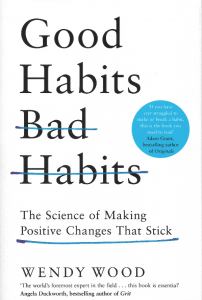The one sentence summary
You can make positive changes that stick to change your habits.
WHAT THE BOOK SAYS 
- This is all about the science of making positive changes that stick. It explains that we have a second self that does things without thinking 43% of the time. That’s a habit, not a conscious decision.
- Our non-conscious self is always forming habits that enable us easily to repeat what we have done before, but we have little conscious experience of forming these habits.
- Top-down processing is when we try to control our unwanted habits with our better intentions. It doesn’t always work, because intentions don’t have much bearing on achieving them. Persistence holds more sway if trying to generate a good habit.
- Bottom-up processing means that we mindlessly respond to environmental clues in the world as we find it.
- A working definition of a habit is a mental association between a context cue and a response that develops as we repeat an action in that context for a reward.
- A shorthand version is automaticity in lieu of conscious motivation. It turns the world around you – your context – into a trigger to act.
- Habit refers to how you perform an action, not what the action is.
- The introspection illusion is an overriding confidence in our own thoughts, feelings and intentions. We overestimate the extent to which we actively decide to do things. That’s the invisibility of habit.
- Procedural memory is based on the automatic scripts our brains piece together when we repeatedly do the same thing in the same way.
- The good effects that we popularly ascribe to self-control are more accurately described as situational control. We don’t achieve admirable outcomes by exerting willpower. We do so by forming powerful habits to automate our behaviour to accomplish our goals – good habits.
WHAT’S GOOD ABOUT IT
- The three bases of habit formation are:
- Context: how and where are more important than what you do.
- Repetition: the more you do it, the more you don’t think about it.
- Reward: you have to get something out of it that is bigger and better than what you would normally experience for it to stick.
- Insensitivity to reward is the gold standard for identifying a habit. If we persist even when we don’t value the reward as much or it’s no longer available, then it’s a habit.
- In essence, the 4 steps to creating a habit (for better or worse) are:
- Create a stable context (same time, same place).
- Reduce friction by removing restraining forces to make it as easy as possible (or increase friction if trying to stop the habit).
- Make it rewarding to do (or not do it if trying to stop the habit).
- Repeat until it becomes automatic.
WHAT YOU HAVE TO WATCH
- The book is well-written, but you have to dig hard for the nuggets and there is no at-a-glance summary of how to form or break a habit.
